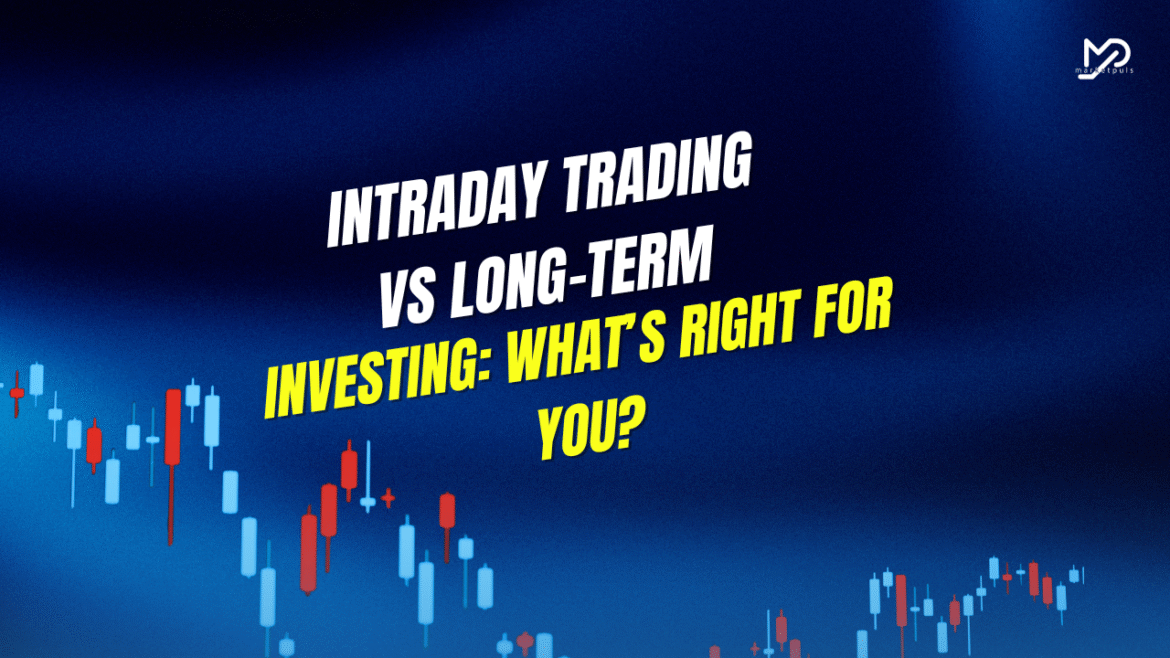When it comes to the stock market, two popular approaches stand out: intraday trading and long-term investing. Each has its own strategies, risks, and rewards, making them suitable for different types of investors. This guide breaks down the key differences, benefits, and challenges to help you decide which approach aligns with your financial goals, lifestyle, and risk tolerance.
What is Intraday Trading?
Intraday trading, also known as day trading, involves buying and selling stocks within the same trading day. Traders aim to profit from short-term price fluctuations, often holding positions for minutes or hours.
Key Features of Intraday Trading
- Time Horizon: Positions are closed before the market closes each day.
- Goal: Capitalize on small price movements for quick profits.
- Tools: Relies heavily on technical analysis, charts, and real-time market data.
- Risk Level: High, due to rapid price swings and leverage often used.
Benefits of Intraday Trading
- Quick Returns: Profits (or losses) are realized within hours, allowing for rapid capital turnover.
- No Overnight Risk: Since positions are closed daily, you’re not exposed to after-hours market events.
- High Engagement: Appeals to those who enjoy active, hands-on trading and thrive in fast-paced environments.
Challenges of Intraday Trading
- Time-Intensive: Requires constant monitoring of the market, making it unsuitable for those with limited time.
- High Stress: The fast-paced nature and potential for quick losses can be emotionally taxing.
- Costs: Frequent trades lead to higher transaction fees and taxes on short-term gains.
- Skill Barrier: Success demands expertise in technical analysis, market timing, and discipline.
What is Long-Term Investing?
Long-term investing involves buying stocks and holding them for years, often decades, with the goal of building wealth over time. Investors focus on a company’s fundamentals and growth potential rather than short-term price movements.
Key Features of Long-Term Investing
- Time Horizon: Typically spans years or decades.
- Goal: Achieve capital appreciation and, in some cases, dividend income.
- Tools: Relies on fundamental analysis, such as evaluating financial statements and industry trends.
- Risk Level: Moderate, as short-term volatility is smoothed out over time.
Benefits of Long-Term Investing
- Compounding Returns: Reinvesting dividends and holding stocks long-term can lead to exponential growth.
- Lower Stress: Requires less daily monitoring, making it ideal for those with busy schedules.
- Tax Efficiency: Long-term capital gains are taxed at lower rates than short-term gains in many countries.
- Simpler Approach: Focuses on quality companies, requiring less technical expertise than day trading.
Challenges of Long-Term Investing
- Patience Required: Returns take years to materialize, which may not suit those seeking quick gains.
- Market Downturns: Long-term investors must endure periods of volatility or bear markets.
- Research Intensive: Choosing the right companies requires thorough analysis of fundamentals and industry trends.
Intraday Trading vs Long-Term Investing: A Side-by-Side Comparison
| Aspect | Intraday Trading | Long-Term Investing |
|---|---|---|
| Time Commitment | Full-time, constant monitoring | Minimal, periodic reviews |
| Risk Level | High, due to volatility and leverage | Moderate, smoothed by long-term horizon |
| Profit Potential | Quick, but smaller per trade | Slower, but potentially larger via compounding |
| Skills Needed | Technical analysis, market timing | Fundamental analysis, patience |
| Costs | High (fees, taxes on short-term gains) | Low (fewer trades, lower tax rates) |
| Emotional Demand | High-stress, fast decision-making | Low-stress, disciplined approach |
Which Approach is Right for You?
Choosing between intraday trading and long-term investing depends on your personality, goals, and resources. Here’s a quick guide to help you decide:
Intraday Trading May Suit You If:
- You have significant time to dedicate to trading (several hours daily).
- You’re comfortable with high risk and can handle financial losses.
- You enjoy fast-paced, analytical tasks and have a strong grasp of technical analysis.
- You prefer quick results and don’t mind the stress of constant market monitoring.
Long-Term Investing May Suit You If:
- You have limited time and prefer a hands-off approach.
- You’re risk-averse and want to minimize emotional stress.
- You’re focused on building wealth gradually for goals like retirement or major life events.
- You’re willing to research companies and hold investments through market ups and downs.
Can You Combine Both Approaches?
Some investors use a hybrid strategy, allocating a portion of their portfolio to long-term investments for stability and another portion for intraday trading to pursue quick gains. For example, you might invest 80% in a diversified, long-term portfolio and use 20% for day trading. This approach requires careful risk management and discipline to avoid letting short-term losses derail your long-term goals.
Final Thoughts
Intraday trading and long-term investing offer distinct paths to wealth creation, each with its own rewards and challenges. Intraday trading is best for those who thrive in high-energy environments and can commit significant time and resources. Long-term investing suits those seeking a low-maintenance, steady approach to building wealth over time. Assess your goals, risk tolerance, and lifestyle to choose the strategy that’s right for you—or explore a combination of both to balance risk and reward.
Disclaimer: Both intraday trading and long-term investing involve risks, and past performance does not guarantee future results. Consult a financial advisor before making investment decisions.


